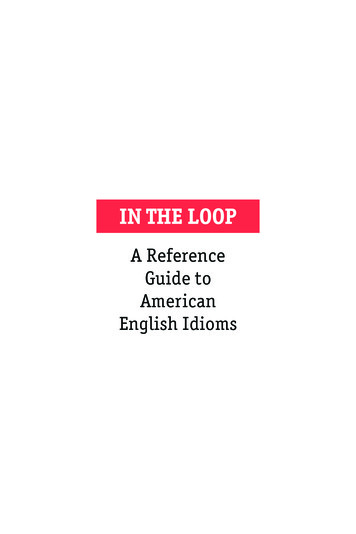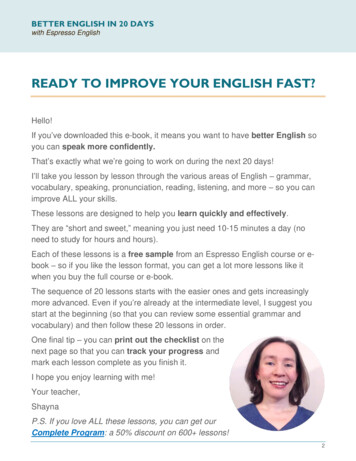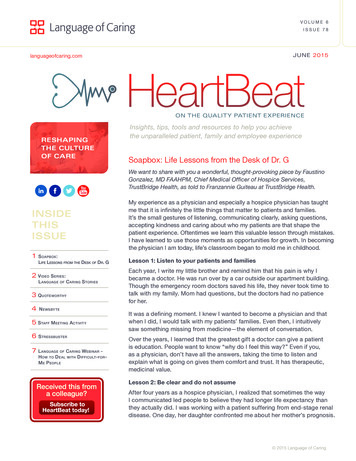
Transcription
Lessons in LifeBy Bridgette Bryant & Daniel HoBridgette Bryant’s voice is at once clear, powerful, and soulful in thisR&B folk mix. In Lessons in Life, Bryant reminds us that life lessonsare not always easily mastered, and encourages respect for allcreatures, large and small. Lessons in Life comes from the album ofthe same name, in which Bryant and co-writer Daniel Ho use songsto teach children about respecting others and themselves, amongother life tate.gov
11Song 1: Lessons in LifeACTIVITY MENUPRE-LISTENINGFour CornersUnscramble the SentencesPicture DictationLISTENINGRelax and Enjoy!Listening Gap-FillFind the MistakesSINGINGSing Along With MeShow Me the WordDisappearing SongPOST-LISTENINGSpeaking: Silly StoryReading: Main Ideas and/or Specific DetailsWriting: Paragraph Posters83americanenglish.state.gov
22Lessons in Life: Lyricsby Bridgette Bryant(2:26)1Having a friend is like planting a flowerShow love and kindness it one day will bloomLet's be aware as we walk on this planetEven the tiniest creature needs room.5Lessons in life aren't always so simpleNothing you're given will ever come freeEven the smallest of gifts deserves "thank you"I respect you and you respect meI think of you and you think of me.10Remember everyone here is importantWhen you're forgotten, it makes you feel sadKnow that you matter and you make a differenceLet no one shame you or make you feel bad.Lessons in life aren't always so simple15Nothing you're given will ever come free (nothing ever gonna come to you freely)Even the smallest of gifts deserves "thank you"I respect you and you respect meI think about you and you think about me. (I think of you and you think of me)19Lessons in life aren't always so simpleNothing you're given will ever come freeEven the smallest of gifts deserves "thank you"I respect you and you respect meI think of you and you think about me. (I think of you and you think of me)84americanenglish.state.gov
Post-listening - Speaking 4: Silly StoryPurpose: To tell stories, and practice using new vocabulary in sentencesLevel: 2 and aboveTime: 15 – 20 minutesPreparation and Materials: Choose 15 – 18 key content words from the songs (either verbs or nouns)and write them on small cards. Each group of five students will need one set of cards.Instructions:1. Divide students into groups of five. Have them sit around a table or move their desks to face eachother. Place the pack of cards face down in a stack on the table or desk, so that the studentscannot see the words.2. Tell the students that they are going to tell a story using the words on the cards. The first personin the group selects the top card and makes up a sentence using that word. Example: If the wordis rain, the first student might say, Once upon a time a little girl was walking in the rain.3. The second person then selects the next card. That person must continue the story by making upa sentence using the word on the card. Example: If the word is yellow, the person might say,The little girl was wearing a yellow coat.1. Students continue telling the circle story until they have gone through all of the cards.2. At the end of the activity, you can ask a few groups to tell what happened in their stories.Modifications:A. extension writing timeAsk the students to write down their stories. Post all of the stories onthe walls around the classroom. Ask the students to read the otherstories and vote on which one is the best, the funniest, or the mostcreative.B.- difficulty scaffolding materials picturesInclude both a small picture and the written word on each card.C.- difficulty writing timeD. humorGive each group a smaller set of words. Have students write down theirsentences/short stories. Have each group share their short story. Then,as a class, come up with transition sentences that link all of the shortstories together into one longer story.Modifications (cont.)To make a really silly story, have the first student follow Step 2 above.Then, have the second student choose a card, but this time they mustrepeat the sentence that the first student came up with, replacing oneword in the sentence with the word on the card. Repeat until all of theword cards have been used, and a really strange story results.americanenglish.state.gov
33Lessons in Life: Silly ericanenglish.state.gov
Motivation through MusicWhen life is difficult, people sometimes use songs and music as tools to bring a little happinessback into their lives. People may also use songs and music to help remind themselves about theimportant things in their lives. We call this type of music ‘motivational music’ because it giveslisteners encouragement1 to act or think in a certain way. Thistype of music can leave a lasting impression2 on our lives.Lessons in Life is a great example of the kind of motivational musicthat is popular in America today.Often these songs encourage the listener to do what is right orthink more positively about life. For example, Lessons in Lifereminds us that the lessons we learn as we go through life aren’talways simple or easy to learn, such as respecting even thesmallest creature. The purpose of these lines might be toencourage us to work hard at learning these lessons and being agood person. However, each person may understand the message of a motivational song in adifferent way. We all hear the same song, but we all have different lessons to learn in life and sowe take away something different from the song.Motivational songs have simple tunes that often use repeated wordsand rhythms. This means that anyone can remember and sing thesong. This type of motivational music is not new. In fact, motivationalmusic has a long history in the United States. For example, duringthe American Revolution (1775 – 1783) when the American coloniesfought an important war for independence from British rule, Americansoldiers sang motivational songs such as Yankee Doodle. This songwas first sung by the British to make fun of the American soldiers (theword ‘doodle’ refers to someone who is simple-minded3). However,the American soldiers soon stole the song, changed some of thewords, and used the song to make fun of the British soldiers instead. What a switch! YankeeDoodle quickly became a song that motivated the American soldiers. Although it was a difficulttime, this light-hearted4 song helped lift their spirits5 because itbecame a symbol of their pride and patriotism.6Today, it is common for popular music from movies to become nationalsymbols of hope, motivation, and determination. For example, singer andactress Judy Garland made the song Over the Rainbow famous in the1939 movie The Wizard of Oz. In the song, Garland sings about finding aplace in the world where skies are blue, bluebirds fly, and troubles “meltaway,” or disappear. The song was very influential,7 perhaps because itexpressed the country’s longing8 and hope for a better world during wartime.1encouragement the act of giving hope and support to another personleave a lasting impression to have a strong influence that remains for a long time3simple-minded not intelligent, lacking good judgment4light-hearted happy, cheerful, not serious5lift (someone’s) spirits to make someone feel happier or better; to cheer up someone6patriotism love that people feel for their country7influential having the power to move or change others8longing to want something very much2americanenglish.state.gov
reminds us that the lessons we learn as we go through life aren’t always simple or easy to learn, such as respecting even the smallest creature. The purpose of these lines might be to encourage us to work hard at learning these lessons and being a good person. However, each pers










